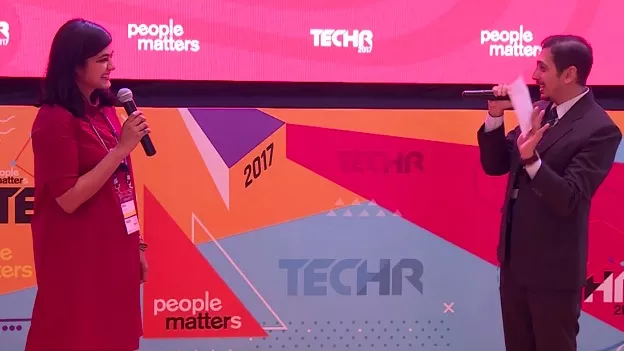You have to nurture culture, you have to prune it

Vikram Choudhary, Research Lead, Bersin by Deloitte and Ektaa Aggarwal, Former Creative Director at Ideo.org. in conversation with one another during People Matters TechHR 2017. Here is the edited excerpt from the conversation that happened.
You can also view the complete video here: Why is organizational culture important?
Vikram asks, Ektaa answers.

Culture is what you do, so the first question really is about culture. Why is culture so important?
Today culture is imperative.
Culture is an experience. Experience is brand. And brand equals reputation.
So culture, therefore, is equal to your reputation. Today, it is actually the make or break factor when consumers hear about our companies, about our products.
It is critical to talk about culture when it comes to employee retention, innovation. Culture today is not a conversation that happens behind closed doors. Culture matters to consumers, therefore it is very relevant.
Changing or building or altering culture is by no means an easy thing. What exactly do you think are the challenges? What would the top three or four challenges be?
I think before I answer this question, I would like to set the context about how I think about culture. I think culture, the way I look at it is a set of values and a set of practices within the organization. I think Teresa Brazen puts it very nicely and I like her definition- “what are the values through the mission statement in an organization, that translates into the vision of the organization and how do those values translate into everyday habits?”
The way we need to actually think about culture; my design colleague Mia Bloom puts it very nicely- "Be a gardener."
You have to nurture culture, you have to prune it. You have to think of it as a hedge.
So culture by behavior is emergent, but you also have to be in the gardening mentality to groom culture on a daily basis. Therefore, you really have to watch for it. It is by no means controllable, but if you understand the levers correctly, leadership is in a great position to shape culture. And understanding how you can shape culture through the organizational levers such as environments, incentives, activities, learning etc. is important.
Could you tell us about the critical players in the organization responsible for shaping and building the organization’s culture?
The business of culture design is everybody’s business at the company. It’s no one person’s business. But of course, you need to start somewhere. So putting together an initial cohort, whether it is led by HR or by the Creative Director, it is important to understand what may not be working so well in the culture.
Research activities, observations, journaling, documentation will slowly start to lead the way towards change management of culture. It could be as simple as coming together and understanding the company’s vision. Very often we take the vision of a company for granted. Do the employees in the company understand the vision for the company? At times, the vision is not really translated or made personal for employees, and that connection is just not there. That is a cultural problem. That is everybody's problem.
What is human-centered design? And what capabilities does an organization or HR in an organization need in order to build human-centered design?
There are a lot of misconceptions about human-centered design. I think human-centered design is seen as the silver bullet to solve all problems. It’s also seen very often as a lateral way of thinking, and also human-centered design is more fluid.
Human-centered design is a process. It’s not a silver bullet. It’s a way of conducting research, a way of getting to the latent state of understanding the ‘why’ i.e. the ‘why’ behind why a user or a consumer is acting one way. “What is the latent need state that we need to design for?”
Very often, we are so disconnected and we don’t really understand the problem that we all are facing when it comes to solution-building. So, human-centered design is imperative when it comes to deep dive research and to cultivate empathy for a user group. It’s great to get to a minimum viable product (MVP), to prototype fast and to save a lot of dollars.
It really gives us the courage to fail fast and fail quickly.
Can you tell us about one application for the same?
One can apply human-centered design to the way we design our culture in our organizations. We can use this very design process to try to understand if there is something that needs fixing. You could use the design process in itself in terms of understanding new behaviors, designing new rituals for the organization, and really understanding what are the effective levers in the system we need to design for. Human-centered design is very critical to that process.
What are the risks that you see when organizations or people do not pay adequate attention to the development of culture?
Culture is reputation at the end of the day. If you ignore it long enough, you are going to start having very dissatisfied customers. Today customers are very savvy, they are looking for their own purpose in the brands that they love. And today culture needs to match their purpose. Customers need to feel like this is a product or service or company that is in line with my own purpose in life. It is as simple as that. If you are not going to do anything about that, you are turning away customers.
What has been your experience with culture and why do you feel it is emergent?
One example of how something is emergent as well as how something needs to be groomed or gardened is a lovely story from Ideo. We have a concept called War Rooms - project teams are in there, typically a group of three to five people working on one project for a period of three weeks to months.
War Room is basically where you build your own semi-permanent structure for your own project. So you have your own War Room. It was a really great practice because it meant that we were putting our research and our synthesis into it. Depending on the industry that we were working on we would design that space to be inspiring to that industry. This was a great and much-celebrated practice and it quickly became the way a lot of the design industry was doing work - in small teams in their War Rooms. This started off as a great practice, but gradually War Rooms and teams started getting insular, with everybody in their own huddle and not enough sharing going on within the studio. So nobody knew what was going on with the other team.
We have an Experience Design Team at Ideo that takes care of and keeps a watchful eye on such things, this is about being a great gardener. They identified that there was not enough conversation and cross-pollination going on amongst teams. We at Ideo think that teams can be inspired by cross-industry, different projects.
So the Experience Design Team designed what they called the “Ideo Tea Time” on Wednesdays, a very interesting concept. A bell went off and the smell of really wonderful baked goods came from the kitchen. These were signifiers of tea time. So project teams would come out of their war rooms and start to talk about their projects, and share inspiration. If teams were stuck at certain places, there would be cross-pollinating and sharing of ideas. That’s a really nice story of how something is emergent, is quickly adopted by a large studio, but how you also have to be the gardener. The Experience Design Team was actually making sure that there was sharing happening.
Note: This interaction happened during People Matters TechHR 2017. The excerpts of the same have been taken to create this. You can view the video of the session here: Why is organizational culture important?












